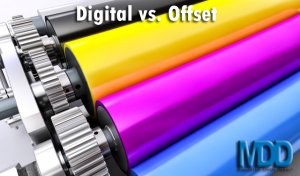 If you were ever given the initiative to start a major print marketing campaign, did you find yourself completely overwhelmed by some of the printing terminology? Driving a marketing campaign is extraordinarily different from knowing the correct paper to use, how to set up the artwork files, and knowing if the end product needs an Offset or Digital printer. Many times even a seasoned graphic designer is also unaware of the many design specifications needed to finish a successful print product. MDD is here to help give you a short overview about the difference between offset and digital printing to help make your job easier.
If you were ever given the initiative to start a major print marketing campaign, did you find yourself completely overwhelmed by some of the printing terminology? Driving a marketing campaign is extraordinarily different from knowing the correct paper to use, how to set up the artwork files, and knowing if the end product needs an Offset or Digital printer. Many times even a seasoned graphic designer is also unaware of the many design specifications needed to finish a successful print product. MDD is here to help give you a short overview about the difference between offset and digital printing to help make your job easier.
You may wonder why you should know the difference between these printing types, though categorically there are a number of reasons you should explore the difference between the two. Among a variety of your options to consider is cost, quantity, size and the design for your project. Knowing the difference between these print options can help make your experience an easy process, along with producing a phenomenal looking end-product.
Offset is a printing process that has been around for quite some time. According to HowStuffWorks.com, offset lithography involves a mechanical process of adding ink layers to paper with a host of rubber rollers and plates. On a four-color press, each tower has its own ink: Cyan, Magenta, Yellow and Black, alternatively called CMYK. These rollers individually transfers their respective ink, by building dot patterns while creating images and text on the selected medium. Special colors, from the Pantone Matching System (PMS,) can be added if the print job requires more specific coloring, like for a logo. The intricate nature of the offset process typically means this type of printing could negatively affect your budget by being costly if the rest of the specifications, such as quantity, are not a good match.
The digital printing process is a bit more simplified. Because the roller/plate process of offset printing is eliminated, there is virtually no set-up involved, thus creating a cost-effective process for smaller formats, smaller quantities and lends to a quicker turnaround time. However, sometimes PMS colors are difficult to completely match, adversely affecting the quality of the print job at hand.
Now that you are armed with a bit more information on the subject, let’s explore examples of your print options:
Ready for your Offset or Digital print job? Manhattan Digital Direct has the expertise and knowledgeable staff to help you successfully complete your creative print design project! We are more than happy to help you, so please contact us today, or call (646) 507-5280.
